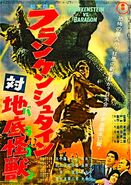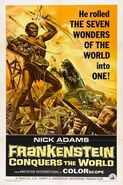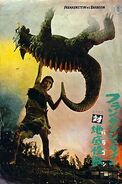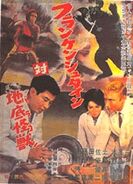Frankenstein Meets the Underground Baragon (フランケンシュタイン対
Plot[]
Japanese Version[]
|
|
SPOILER WARNING: This section may contain major plot and/or ending details. Proceed at your own discretion. |
|---|
Hiroshima has been around for more than ten years since the end of the war. Dr. Bowen studying cell tissue (Nick Adams), his colleagues Kawachi (Tadao Takashima), and Riko Toyama (Kumi Mizuno) have decided to take care of a white man with unknown parents. He grows twice as much as Riko and can no longer live with humans. The monsters chained in the warehouse and the press concentrated in Hiroshima.
Lieutenant Kawai announces that he has taken Frankenstein's heart from a German submarine shortly before the end of the war. I speculated that the heart might have gained protein and became this monster. If this monster was regenerated from Frankenstein's heart, even if he cuts his limbs, new limbs should come out. The monster who was angry at the TV interview broke through the warehouse and jumped out. Later, a chained wrist was roaring on the floor.
At that time, Frankenstein ran away after eating livestock in Okayama and Himeji. There is information that there seems to be another monster at that time. Baragon and Frankenstein, who appeared from the basement at the foot of Mt. Fuji, confront each other. In the overseas version, Frankenstein, who defeated Baragon, confronting Oodako (Giant Octopus) for some reason, and was dragged into Lake XX and died.
American Version[]
|
|
SPOILER WARNING: This section may contain major plot and/or ending details. Proceed at your own discretion. |
|---|
At the end of World War II, Dr. Reisendorf's laboratory in Berlin Germany near the fall brought, "something" to Japan all the way to the Nazis , and even transferred it to Hiroshima 's Hiroshima Ebisu Hospital, even at the expense of the U-boat. Was done. In response to the question of Captain Kawai, who is responsible for the transfer, the chief medical officer explains that it is "the immortal heart created by Dr. Frankenstein." As a trump card of the Great War, it was a secret Japanese-German operation to create an immortal soldier based on this heart with eternal life force. However, it was suspected that it was extinguished shortly after by the explosion of an atomic bomb dropped by the US military .
Then, time passed, 1960 , 15 years later . A dog in a house in Hiroshima Prefecture was killed by someone, and an isolated carcass of a rabbit was found at an elementary school. Also, on a night when it rains heavily, a mysterious wandering child is run by a taxi. A few days later, this wandering child, who was wandering around Miyajima , was protected by Dr. Bowen and his assistant, Noriko Togami, of the International Institute of Radiological Medicine. The boy is a Caucasian, and in a short period of time he will grow rapidly and become a giant up to 20 meters. Because of his low intelligence and unpredictable behavior, Bowen and his colleagues, who were troubled by their disposition, would "bred" them by chaining his wrists in a special room with a bar. Tokiko loves him by calling him "little boy."
Meanwhile, Kawai, who had been an engineer in the Akita oil field , witnessed a giant monster-like thing during the earthquake that hit the oil field. It was a huge reptile baragon that survived the great extinction by digging underground at the end of the Mesozoic era . At the same time, when Kawai heard news from the International Institute of Radiological Medicine, he wondered if the giant had been brought to Japan shortly before the war, that is , the immortal heart of " Frankenstein " was a human form. , Visit the source of Bowen. In response to Kawai's confession, Dr. Kawachi flew to Frankfurt, Germany, and said, Dr. Reisendorf, "If it was Frankenstein, I could cut off a part of my body, anywhere on my wrist. It should be regenerated."
The "boy" who has grown into a giant has become a popular subject matter for the media and will be flooded with interviews. Around that time, Kawachi, who returned from Germany, decided to cut off the hand of "boy" and headed to a special room, where the staff of the TV station who received permission to interview appeared. Kawaji instructed him not to hit the light because he was excited, but the TV staff ignored it violently and turned the lighting inside the iron bar. As a result, "boy" gets excited and runs out of the laboratory. In the destroyed special room, a torn left wrist is found with a handcuff, and it goes around the floor in search of protein , and it turns out that "boy" is "Frankenstein".
Frankenstein, who escaped, fled east from Hiroshima through Okayama , Himeji , and Lake Biwa in the darkness , and headed north to around the Japan Alps , where the climate is close to his hometown of Germany . On the other hand, Baragon is Shirane had been prey on humans and animals in the vicinity, the presence of Baragon kill eating all the witnesses in order to move the underground is not recognized, the world is Frankenstein struck the man, than have eaten the I start to doubt that there is. In this way, hard-line measures such as the dispatch of the Self-Defense Forces were implemented, and Frankenstein was discovered at the stone cutting site, so the government decided that a series of cases was his work, and decided to bury him. Bowen and his colleagues also got a sample called a "wrist," so I can't strongly oppose it.
In this way, when the SDF special vehicle unit headed to the foot of Mt. Shirane, the "wrist" that had come out of the culture solution was found dead in the laboratory, and Bowen and others had no choice but to reconsider the breeding of Frankenstein himself. In addition, based on eyewitness testimony of a luminous body (corner of Baragon) that Kawai witnessed in the Akita oil field and a similar phenomenon at the stone cutting site, Bowen and others who are trying to dispel Frankenstein's innocence We will continue our efforts to pay this by dropping. As Bowen and Tokiko enter the waters of the Japanese Alps, Kawaji proposes that the only weak point of the giant, the eyes, should be neutralized with flares. However, in response to the light from the flare thrown by the river, Baragon, the true criminal, appears from the bottom of the ground. Baragon approaches the Bowen, who are desperately dead, but Frankenstein closes in front of them.
Cast[]
- Nick Adams as Dr. James Bowen (Japanese voice actor: Gorō Naya)
- Tadao Takashima as Dr. Ken'ichiro Kawaji
- Kumi Mizuno as Dr. Sueko Togami
- Yoshio Tsuchiya as Mr. Kawai
- Yoshifumi Tajima as Murata
- Takashi Shimura as Hiroshima surgeon
- Susumu Fujita as Osaka Police Chief
- Peter Mann as Dr. Riesendorf (Japanese voice actor:Kazuo Kumakura)
- Keiko Sawai as Tazuko Towoi
- Koji Furuhata as Frankenstein
- Sumio Nakao as the younger Frankenstein
- Haruo Nakajima as Baragon
Staff[]
- Directed by Ishiro Honda
- Written by Reuben Bercovitch, Kaoru Mabuchi, and Jerry Sohl
- Produced by Tomoyuki Tanaka, Reuben Bercovitch, Henry Saperstein, and Samuel Arkoff
- Music by Akira Ifukube
- Cinematography by Hajime Koizumi
- Edited by Ryohei Fuji
- Production design by Takeo Kita
- Assistant Director Koji Kajita
- Director of Special Effects Eiji Tsuburaya
- Assistant Director of Special Effects Teruyoshi Nakano
- Based on characters created by Mary Shelley
Titles[]
- Frankenstein to conquer the Earth (italian title)
- Frankenstein vs. The Underground Baragon (alternate reading of Japanese title)
- Frankenstein vs. Subterranean Monster Baragon (フランケンシュタイン対地底怪獣バラゴン Furankenshutain tai Chitei Kaijū Baragon?, Alternate Japanese title)
- Frankenstein Conquers the World (United States)
- Frankenstein vs. the Giant Devil-fish (early U.S. title)
- Frankenstein: The Horror With the Ape Face (Frankenstein – Der Schrecken mit dem Affengesicht; Germany)
- Frankenstein Against The World (Frankenstein Contra o Mundo; Brazil)
Lost Alternate Ending[]
The 1965 Toho-UPA co-produced kaiju film Frankenstein Conquers the World (also known as Frankenstein vs. Baragon) had an alternate ending that was intended for the American release but was never used. The scene itself involved Frankenstein battling a Giant Octopus (known as Oodako) in the climax of the film, after defeating his main opponent of the film, Baragon. He fought fiercely, but eventually succumbed to the many tentacles and long reach of the octopus and was dragged into the water.
In the normal ending, he is simply sucked into the ground by an earthquake.
Information[]
Stills of the scene were shown to the public in various trade magazines such as Famous Monsters of Filmland in the 1960s, confusing readers into the confusion of the magazine writers. The film was also titled Frankenstein vs The Giant Devilfish in these magazines, further confusing readers.
According to director of the film Ishiro Honda, there were more ending concepts, and that the octopus scene was just one of the five or six endings.
"The movie was made in co-production with an American company, Benedict Pictures Corporation. The bosses were so astonished by the octopus scenes from King Kong vs. Godzilla, they begged to include it into the screenplay, even in spite of logic. So we shot some scenes with the Giant Octopus but, in the end, they were left out of the picture."
"In fact Mr.Tsuburaya had shot five or six final scenes for this film. The infamous giant octopus is only one of these endings. That is, the top brass at Toho was told the giant octopus scenes in King Kong vs Godzilla were popular in the U.S., and so they wanted a similar scene in this production. But in the end it was rejected by the U.S side (by Henry Saperstein) as "too abrupt", and was not used in either the respective U.S or Japanese releases. Furthermore, there was never any official plan to utilize the sequence; but an alternative print with that ending was accidentally aired on television surprising many Japanese fans- because it was not the ending they had remembered from the original theatrical release."
The alternate ending had actually aired on Japenese television after the theatrical release, but no recording of the scene exists. There are some deleted stills of the scene, however, it is just unlikely that the scene will ever see the light of day.
Although this work was televised several years after the release, the last scene was different from the public version, and a big octopus appeared after the giant defeated Baragon. Until recently, the "large octopus appearance version" was stipulated in the Toho-approved literature as "taken again for overseas versions," and even the staff seemed to think so .
On the other hand, according to the instruction manual attached to the DVD released by Toho, the overseas public version has the same ending as the original version, and it is explained that the first release of the large octopus appearance version is at the time of TV broadcasting in Japan as described above. .. The large octopus appearance version has been re-taken not only for special effects, but also for the main part where the person is drawn. In such video is used large octopus appearance version, but those of the original version was becoming with the presence of vision, two versions became to be able to watch (now at DVD 1991 years of VHS 2 kinds to video It is recorded). In addition, the BGM flowing in the big octopus appearance scene uses the song of the big octopus appearance scene in "King Kong vs. Godzilla" as it is.
According to Futami Shobo's "The Mystery of Godzilla 99, the Great Monster", this work has at least three endings.
- Frankenstein is swallowed by a crack in the ground after defeating Baragon (the original version at the time of theater release).
- [1]A scene in which a big octopus appears has been added.
- Frankenstein and Baragon are swallowed by a landslide at the same time .
Frankenstein's method of confirming the death of Baragon is different between the "large octopus added version" and the "original version". The former method was to "kick the carcass of Baragon lightly," while the latter method was to "grab the Baragon's neck, bring your face closer, and see if you are breathing."
Sequel[]
- Main article: Frankenstein's Monsters: Sanda vs. Gaira.
References[]
This is a list of references for Frankenstein Conquers the World. These citations are used to identify the reliable sources on which this article is based. These references appear inside articles in the form of superscript numbers, which look like this: [1]
Gallery[]
Posters[]







